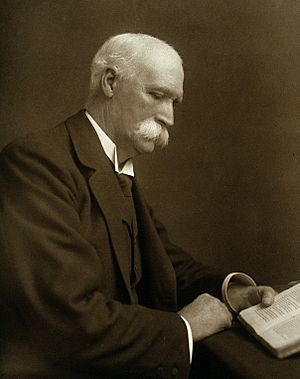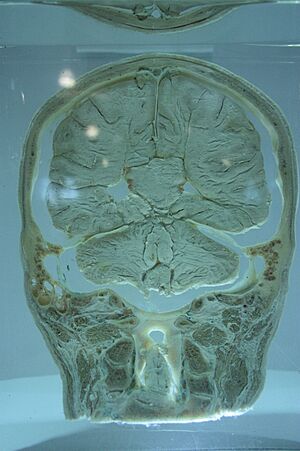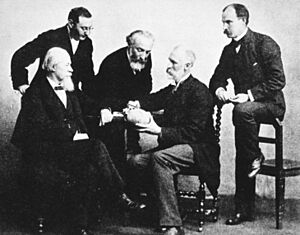William Macewen facts for kids
Quick facts for kids
Sir William Macewen
|
|
|---|---|
 |
|
| Born | 22 June 1848 Port Bannatyne, Isle of Bute, Scotland
|
| Died | 22 March 1924 (aged 75) Glasgow, Scotland
|
| Education | University of Glasgow |
| Known for | Pioneering work in brain surgery, hernia surgery and bone grafts endotracheal anaesthesia pneumonectomy |
| Medical career | |
| Profession | Surgeon |
| Institutions | Glasgow Royal Infirmary Western Infirmary Royal Hospital for Sick Children |
| Sub-specialties | Neurosurgery, Orthopedic surgery |
| Awards | Knighthood Cameron Prize for Therapeutics of the University of Edinburgh (1896) |
Sir William Macewen (born June 22, 1848 – died March 22, 1924) was a famous Scottish surgeon. He was a true pioneer in modern brain surgery. Many people even call him the father of neurosurgery. He also helped develop new ways to do bone graft surgery, fix hernias, and remove parts of the lungs (called pneumonectomy).
Contents
A Surgeon's Journey
William Macewen was born in 1848 near a place called Port Bannatyne in western Scotland.
He studied Medicine at the University of Glasgow and finished his degree in 1872. A very important person who influenced him was Joseph Lister. Lister changed surgery forever by using `antisepsis`. This meant using special chemicals, like `phenol`, to kill germs. This greatly reduced the number of patients who died from infections after surgery.
Macewen followed Lister's ideas. He made sure doctors and nurses thoroughly cleaned their hands and arms. He also made sure all surgical tools were `sterilised` (made completely germ-free). He used `anaesthesia` (medicine to make patients sleep during surgery). By doing all this, Macewen became one of the most creative surgeons of his time. He made surgery much safer and helped patients get better faster.
In 1875, he started working as an assistant surgeon at the Glasgow Royal Infirmary. He became a full surgeon there in 1877. Around 1880, he even started a special training program for nurses. This program focused a lot on how to keep things sterile.
He became a lecturer in surgery in 1881. In 1883, he also became a surgeon at the Royal Hospital for Sick Children in Glasgow. Later, in 1892, Macewen became a professor of Surgery at the University of Glasgow. This was the same job Lister had when Macewen was a student!
He was made a `Knight` by King Edward VII in 1902 for his important work in medicine.
During the First World War, many soldiers lost their arms or legs. In 1916, Macewen helped create the Princess Louise Scottish Hospital for Limbless Sailors and Soldiers near Glasgow. He was its first chief surgeon. He even worked with engineers to design a new type of artificial limb for the soldiers. He trained people to make these limbs at the hospital.
Sir William Macewen passed away in Glasgow on March 22, 1924.
Amazing Brain Surgery
Before Macewen, doctors didn't know exactly where problems were in the brain. But scientists like John Hughlings Jackson and David Ferrier had started to map out brain functions. This meant they learned which parts of the brain controlled different body movements or feelings.
Macewen used this knowledge in 1876. He showed that by carefully examining a patient, he could figure out where a `tumor` or problem area was in the brain. He would watch how the patient's body movements or senses changed. For example, if a patient's arm twitched, it could point to a problem in a specific part of the brain.
In 1876, he correctly guessed that a boy had an `abscess` (a pocket of infection) in his brain. Sadly, the family didn't allow surgery. When the boy died, an examination showed Macewen was right about where the problem was.
Then, in 1879, he did something incredible. He performed the first successful brain surgery where he found the problem area just by looking at the patient's symptoms. A teenage girl had `epileptic` seizures that made her face and arms twitch. Macewen believed this meant there was a problem in a specific part of her brain. He made a small hole in her skull near that spot and found a large `tumor`. He removed it, and the girl lived for eight more years with no sign of the tumor! This was a huge success for medicine.
Macewen also successfully operated on brain abscesses and `hematomas` (collections of blood) in the brain and spine. He was very good at understanding diseases of the `temporal bone` (a bone in the skull) and `nasal sinuses`. He also drew detailed pictures of the inside of the head in his book, Atlas of Head Sections. This helped him treat brain abscesses even before `X-rays` were discovered.
Other Contributions to Surgery
One of Macewen's early achievements was in `orthopaedics` (the branch of medicine dealing with bones and muscles). In 1877, he developed some of the first `bone grafts`. This is where healthy bone is taken from one part of the body and used to fix a broken or missing bone in another part. He also created a special tool, called Macewen's `osteotome`, for knee surgery. These methods became very important for treating `rickets`, a disease that makes bones soft and weak due to a lack of `Vitamin D`.
Macewen was very interested in how bones grow and repair themselves. He did many experiments on animals to learn more about this.
He also developed surgical ways to treat `mastoid disease` and `pyogenic cysts` (infected sacs) in the `temporal bone`. There's even a small part of this bone named after him, called `MacEwen's triangle`.
His method for surgically removing parts of the lungs became a major way to treat serious diseases like `tuberculosis` and `lung cancer`. This saved many lives. His name is also remembered in medicine for two other things: the `Macewen's operation` for `inguinal hernia` (a common type of hernia) and the `Macewen's sign` for `hydrocephalus` (fluid buildup in the brain) and brain abscess.
Another important thing Macewen gave to modern surgery was the technique of `endotracheal anaesthesia`. This involves putting a tube into the windpipe to help a patient breathe and receive `anaesthesia` during surgery. This method, which he described in 1880, is still used today!
Macewen was also one of the first doctors to use photographs to record patient cases and to teach surgery. He took pictures of body parts, diseased tissues, and patients before, during, and after their treatment or surgery.
Honours and Recognition
Sir William Macewen received many awards and honours during his life:
- He became a `Fellow` of the Royal College of Physicians and Surgeons of Glasgow in 1874.
- He was made a `Fellow of the Royal Society` in 1895, which is a very high honour for scientists.
- He became an `Honorary Fellow` of the Royal College of Surgeons of England in 1900.
- He was the `President` of the British Medical Association in 1922.
- He was `Knighted` in 1902.
- He was made a `Companion of the Order of the Bath` in 1917.
After he died, a special fund was created in his name to remember him. In the late 1970s, a new laboratory building at the Glasgow Royal Infirmary was named in his honour. This is where he spent most of his career.
Images for kids




